Derby's Heritage Part 34 - Derwent & Morledge
w/e 28 October 20122
All this week's pictures were taken
with a Kodak DX6490
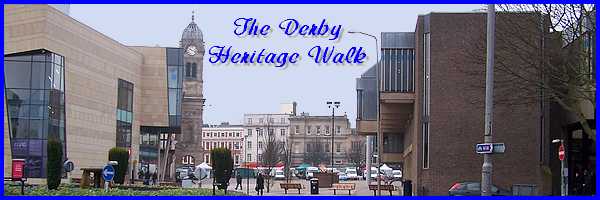
The sun had taken a back seat on a dull and drizzly
day when we visited Derby for this 34th part of the Heritage
Walk and if truth be told, much of the architectural heritage
has been consigned to history by redevelopment schemes in the
area.
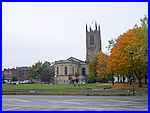 For example
we have already seen how the demolition of the Power Station
has opened up views of the former Collegiate Church (left) from
outside the Silk Mill. The Collegiate College of course was granted
Cathedral status in 1927 and the open space created by the demolition
of the Power Station is now called For example
we have already seen how the demolition of the Power Station
has opened up views of the former Collegiate Church (left) from
outside the Silk Mill. The Collegiate College of course was granted
Cathedral status in 1927 and the open space created by the demolition
of the Power Station is now called  Cathedral Park. Another recent
addition leading from Cathedral Park across the River Derwent
is the controversial pedestrian and cycle swing bridge (right). Whilst its construction
did not meet with universal approval being dubbed "the bridge
to nowhere" it was nominated as a finalist in the 2009 Prime
Minister's Awards for Better Public Buildings. Maybe future generations
will regard it with the same fondness as we regard the buildings
of our Victorian and Edwardian ancestors. Cathedral Park. Another recent
addition leading from Cathedral Park across the River Derwent
is the controversial pedestrian and cycle swing bridge (right). Whilst its construction
did not meet with universal approval being dubbed "the bridge
to nowhere" it was nominated as a finalist in the 2009 Prime
Minister's Awards for Better Public Buildings. Maybe future generations
will regard it with the same fondness as we regard the buildings
of our Victorian and Edwardian ancestors.

A more traditional bridge is just a little way downstream and
can be seen as we approach along the river bank. This is Exeter
Bridge which takes its name from the Earl of Exeter whose house
stood nearby. It was built after the old bridge was demolished
in 1929, the original bridge linking Exeter House with its gardens
on the other side of the river. The new bridge was designed by
Charles Herbert Aslin of the City Architect's Department. Exeter
House was demolished and the bridge widened before the Second
World War.
|
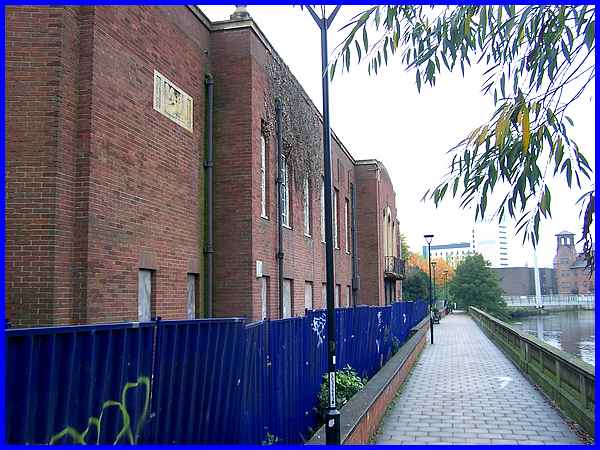
Looking back towards the new swing bridge and the Silk Mill,
the building on the left is the rear of the former Magistrate's
Court with the old Police Station beyond, both of which date
from 1934 and both of which have been allowed to fall into a
state of disrepair and neglect. However in the last few weeks
it has been announced that the Garde II listed Court building
is to be purchased by the City Council and the Local Studies
Library moved there whilst only last week it was reported that
the old Police Station is to be demolished and the site redeveloped.
|
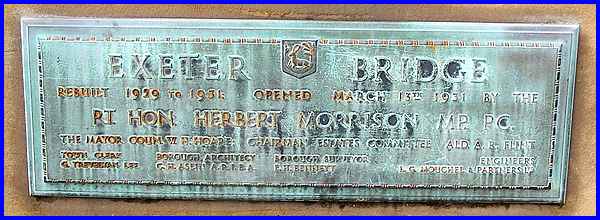
Turning our attention back to Exeter Bridge we can see here too
that decorations on the four pillars at the corner have also
suffered the consequences of weathering. The pillar nearest the
river bank from which we reached the bridge bears the plaque
pictured above which shows that the bridge was opened on March
13th 1931 by the Rt. Hon. Herbert Morrison MP. PC., the then
Minister of Transport in Ramsay MacDonald's government.
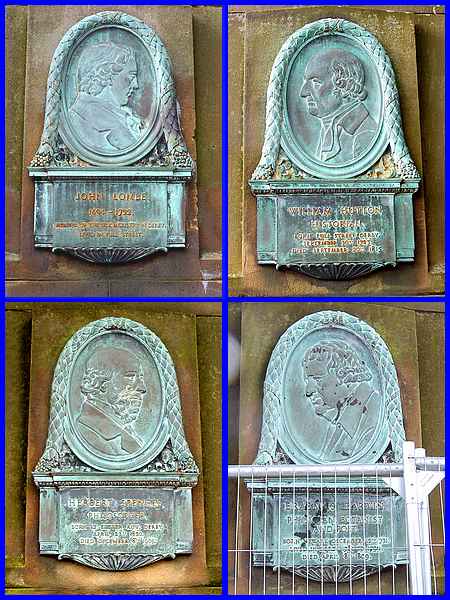
Immediately above the plaque commemorating the opening of the
bridge is one of four Bas relief sculptures of notable Derbeians,
the others being on each of the other three pillars. The one
above the opening plaque is of John Lombe (1694 - 1722) a pioneer
of the silk industry who lived in Full Street and shown above
top left.
The other sculpture on the same side of the bridge as Lombe shows
William Hutton (top right) the historian who wrote the first
published history of Derby in 1791 and who was born in Full Street
on September 30th 1723. As a child he had worked at the Silk
Mill and later became a bookseller. He died on September 20th
1815.
Opposite Hutton is Herbert Spencer (April 27th 1820 - December
8th 1903) who was born at 12 Exeter Row and who became world
famous for his works on philosophy.
Finally and partially obscured by a temporary fence is the figure
of physician, botanist and poet Erasmus Darwin. Although born
in Newark (December 12th 1731) he lived in or near Derby for
about twenty years. The sculpture gives the date of his death
as April 18th 1809 although this is a mistake as his biography
shows that he died in 1802 a few weeks after moving into Breadsall
Priory, just north of Derby and he was buried in Breadsall Church.
Erasmus Darwin, whose grandson Charles Darwin is famous for his
1859 book "On the Origin of Species" also lived in
Lichfield, Staffordshire and his home there, Erasmus Darwin House, is now a museum about
his life and his work.
|
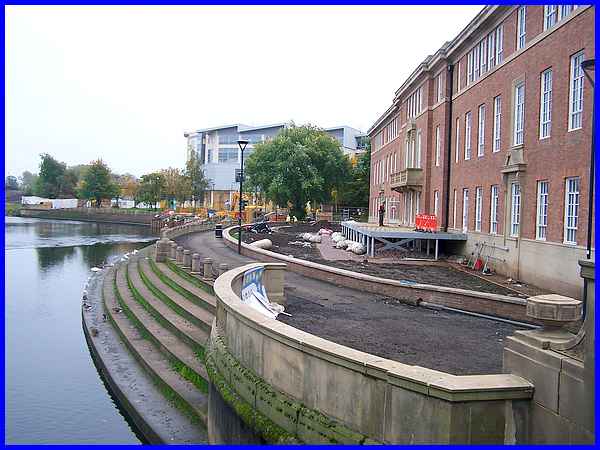
The temporary fence on Exeter Bridge is currently preventing
access to the Riverside Gardens whilst work is carried out of
the Council House, the headquarters of Derby City Council but
it was always my intention to continue along Derwent Street from
the Exeter Bridge to the front of the Council House and into
Corporation Street and The Morledge before returning to the river
bank a little further downstream.
|
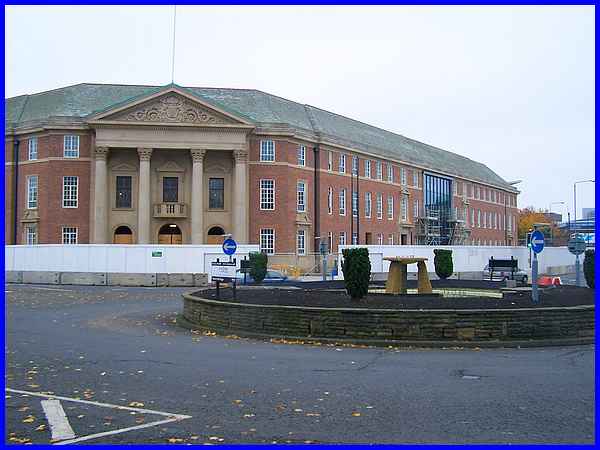
I was hoping that by the time we reached this stage of the walk
that the work on the Council House would be complete but the
white boarding and the temporary walkways in the road show that
it is still ongoing. Constructed as a horse-shoe shaped building
it was delayed by the outbreak of the Second World War and immediately
upon completion was occupied by the RAF in 1942 but eventually
handed over to the Council in 1946. The official opening ceremony
by Princess Elizabeth and her husband Prince Philip took place
three years later in 1949.
|
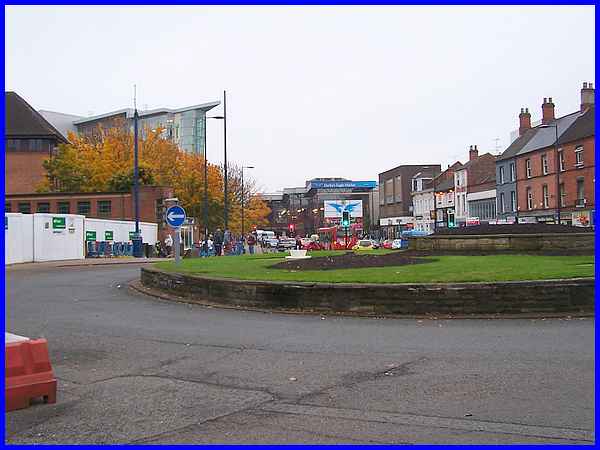
 Passing
along Corporation Street in front of the Council House leads
to this roundabout at the start of The Morledge and it is here
that the heritage of the city is much harder to find. A small
plaque (left) on the roundabout is virtually impossible to read
across the road but with the aid of the camera's zoom lens I
was able to make out "These fountains were presented to
the County Borough of Derby by the White House (Derby) Ltd and
associated companies in commemoration of the Mayorality of Councillor
Walter White Chairman of Directors". I regret the date on
the plaque is indistinct even with the zoom lens. Passing
along Corporation Street in front of the Council House leads
to this roundabout at the start of The Morledge and it is here
that the heritage of the city is much harder to find. A small
plaque (left) on the roundabout is virtually impossible to read
across the road but with the aid of the camera's zoom lens I
was able to make out "These fountains were presented to
the County Borough of Derby by the White House (Derby) Ltd and
associated companies in commemoration of the Mayorality of Councillor
Walter White Chairman of Directors". I regret the date on
the plaque is indistinct even with the zoom lens.
 The
brick building behind the trees in the main picture above is
Derby Crown Court which opened in 1989 on the site of Charles
Aslin's open market of 1931. On a wall nearby is an information
board (right) titled "Shot Tower". An image at Picture The Past shows the area
about 1930 and the accompanying information tells how hot metal
was dropped from the top of the tower to manufacture lead shot.
The information board contains similar details saying that the
tower stood on this site between 1809 and 1932. It was demolished
as part of the Central Improvement Scheme that also included
the building of the Council House. The
brick building behind the trees in the main picture above is
Derby Crown Court which opened in 1989 on the site of Charles
Aslin's open market of 1931. On a wall nearby is an information
board (right) titled "Shot Tower". An image at Picture The Past shows the area
about 1930 and the accompanying information tells how hot metal
was dropped from the top of the tower to manufacture lead shot.
The information board contains similar details saying that the
tower stood on this site between 1809 and 1932. It was demolished
as part of the Central Improvement Scheme that also included
the building of the Council House.
|
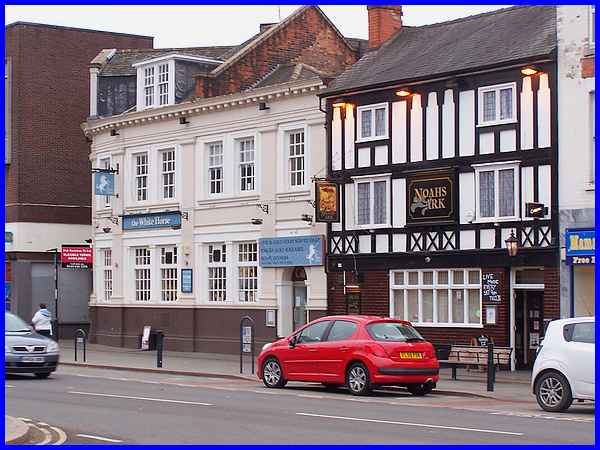
Much of The Morledge has changed in recent years but two old
buildings to survive stand next door to each other. The White
Horse pub (previously called the Court House) has stood here
since at least 1883 but was rebuilt between 1920 and 1923 when
it incorporated a shop on the adjacent Thorntree Lane. The Noah's
Ark dates from even earlier (1822) being named after Noah Bullock,
a 17th century character of low repute who lived in a boat on
the Derwent which he named after his Biblical namesake "The
Ark". He was a forger producing counterfeit coins on his
boat. He had a son called Japhet and legend has it that he had
two more sons called Ham and Shem although this is not substantiated
by records. The current pub replaced the original in 1919, the
timber facade being added in 1926.
|
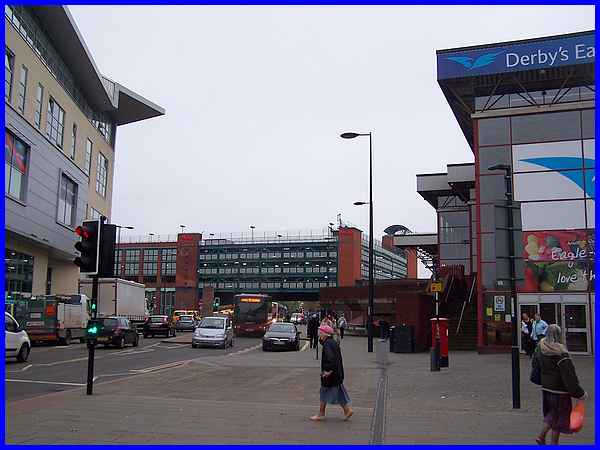
 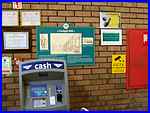 At
this point on The Morledge all the architecture is of the modern
variety with the Riverlights development including the new
bus station on the left, the multi-storey Cockpit Car Park directly
ahead and the Eagle Market on the right. Our route back to the
River Derwent will take us between the Riverlights building and
the Crown Court (right) but surrounded by other notices and behind
a cash machine in the Eagle Market is another information board
(left) relating the history of Cockpit Hill. At
this point on The Morledge all the architecture is of the modern
variety with the Riverlights development including the new
bus station on the left, the multi-storey Cockpit Car Park directly
ahead and the Eagle Market on the right. Our route back to the
River Derwent will take us between the Riverlights building and
the Crown Court (right) but surrounded by other notices and behind
a cash machine in the Eagle Market is another information board
(left) relating the history of Cockpit Hill.
Click here
to see an enlargement of the Cockpit board and there's a gallery
of images of the old Art Deco style bus station, which like Exeter
Bridge was designed by Charles Aslin, on the BBC site here.
|

